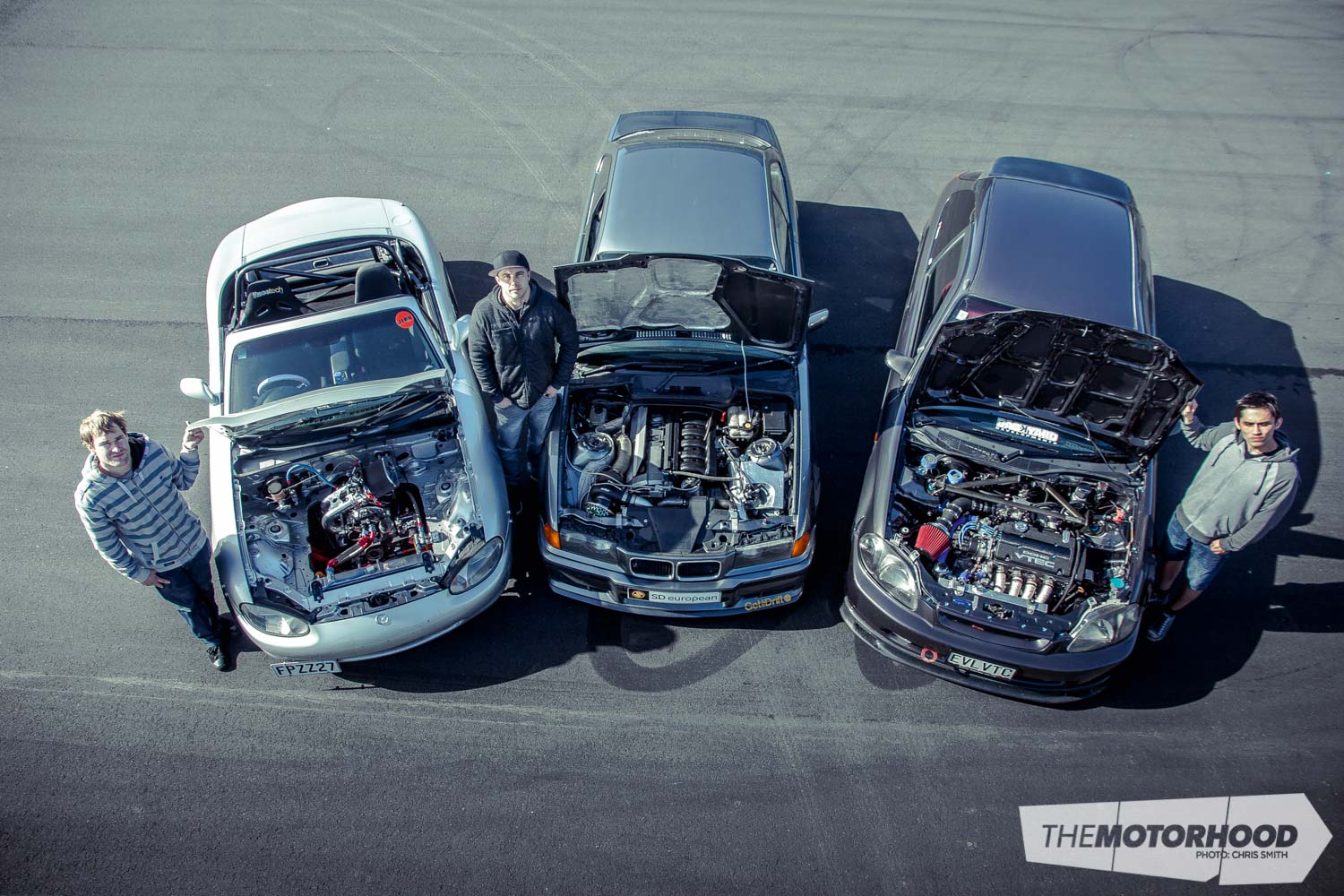
Getting out on your local track at the weekend is a great way to blow off some steam, forget the stresses of life, and find some fun that you just couldn’t have on a public road. It’s one of the greatest parts of car culture, and no matter whether you’re 16 or 80, if you’re throwing it in sideways or searching for every last split second, you’ll have a ball.
We decided to get together three home-built weekend track hacks which are regularly beaten through both circuit and drift disciplines. Each build had to be unique in its own right, with different engine layouts, drive configurations and build approach. So we brought together William Cate with his 13B PP–powered 1999 Mazda MX-5, Garett Daly with his 2.8-litre turbocharged E36 BMW, and Matt Edwards with his H22A-swapped EK Civic. We invited the drivers to Hampton Downs to pit their builds against each other in a few track tests, but really we just loved the idea of getting some cars together to thrash around an empty track.
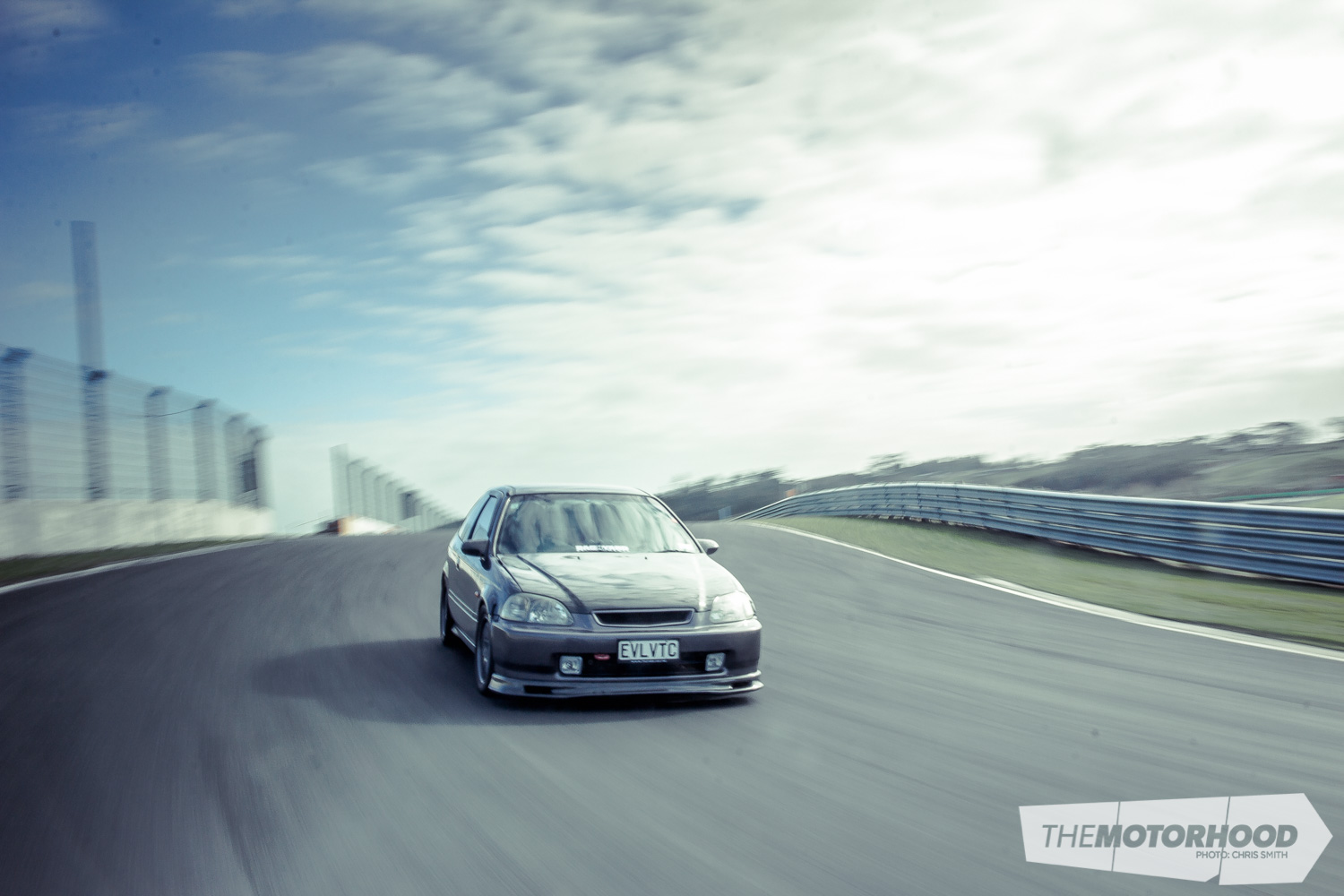
Civic
Matt Edwards’ 1995 Honda Civic SiR EK4 would have to be one of the toughest naturally-aspirated hot hatches in New Zealand. Now on its third engine transplant, Matt’s EK runs the big block of the ’90s Honda engines — the 2.2-litre H22A.
From factory the EK4 SiR ran a B16A2 engine, which Matt soon replaced with a B18CR. After blowing the B18CR up at a Pukekohe track day, Matt got to work on the next transplant, as he explains.
“This time I wanted a set-up which was uncommon in New Zealand. It was a cheap-ish build, which got the power I wanted.”
He was off to a good start when he picked up the H22A from a scrapyard for the measly sum of $300. The intake side of the engine then received a K20A RBC intake manifold, Skunk2 70mm throttle body, and a custom three-inch intake pipe with a Blox velocity stack and Type-S Prelude camshafts.
Exhaust gases exit through a beautiful set of PLM H2B headers, with a custom three-inch collector and full three-inch stainless steel exhaust system, only just toned down by a Megan Racing muffler.
Fuelling is taken care of with K20A 310cc injectors, a K-tuned fuel rail, and K-tuned in-line fuel filter. Ignition has also been upgraded via NGK spark plugs and 8mm NGK racing leads. The H22A now delivers 156kW (209hp) to the wheels, tuned with an AEM V2 and AEM wideband. To keep the Honda on the ground there’s a set of Cusco coilovers, an array of aftermarket bushes throughout and Toyo R888s for grip duties. To stop the car there’s a bolt-on Wilwood brake package, racing pads and Motul high-temp fluid.
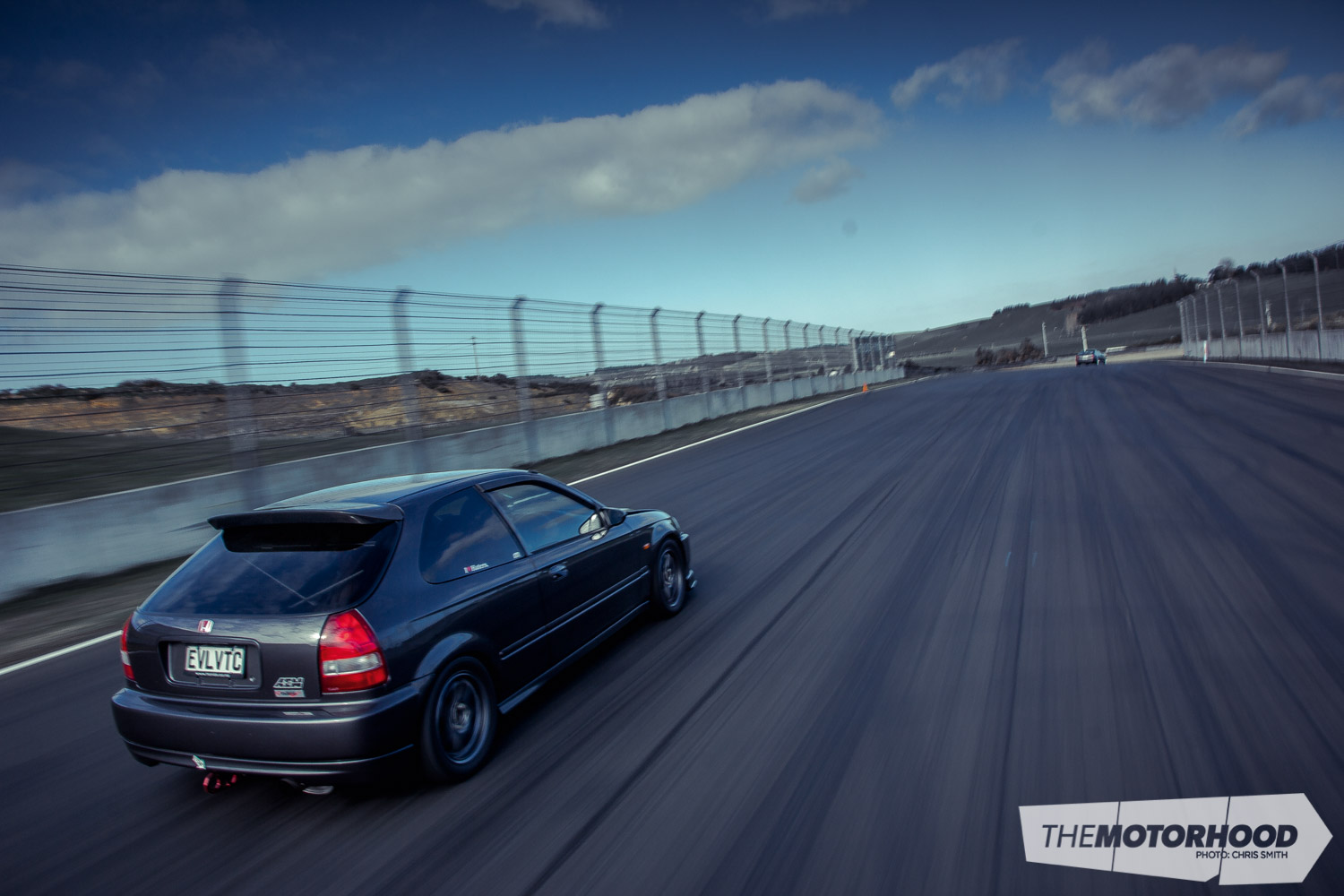
The combination Matt has pieced together is near bulletproof, and though the car’s interior has been stripped and it runs on semi slicks, he often drives as far as Taupo, beats on it all day out on track, and then drives home again.
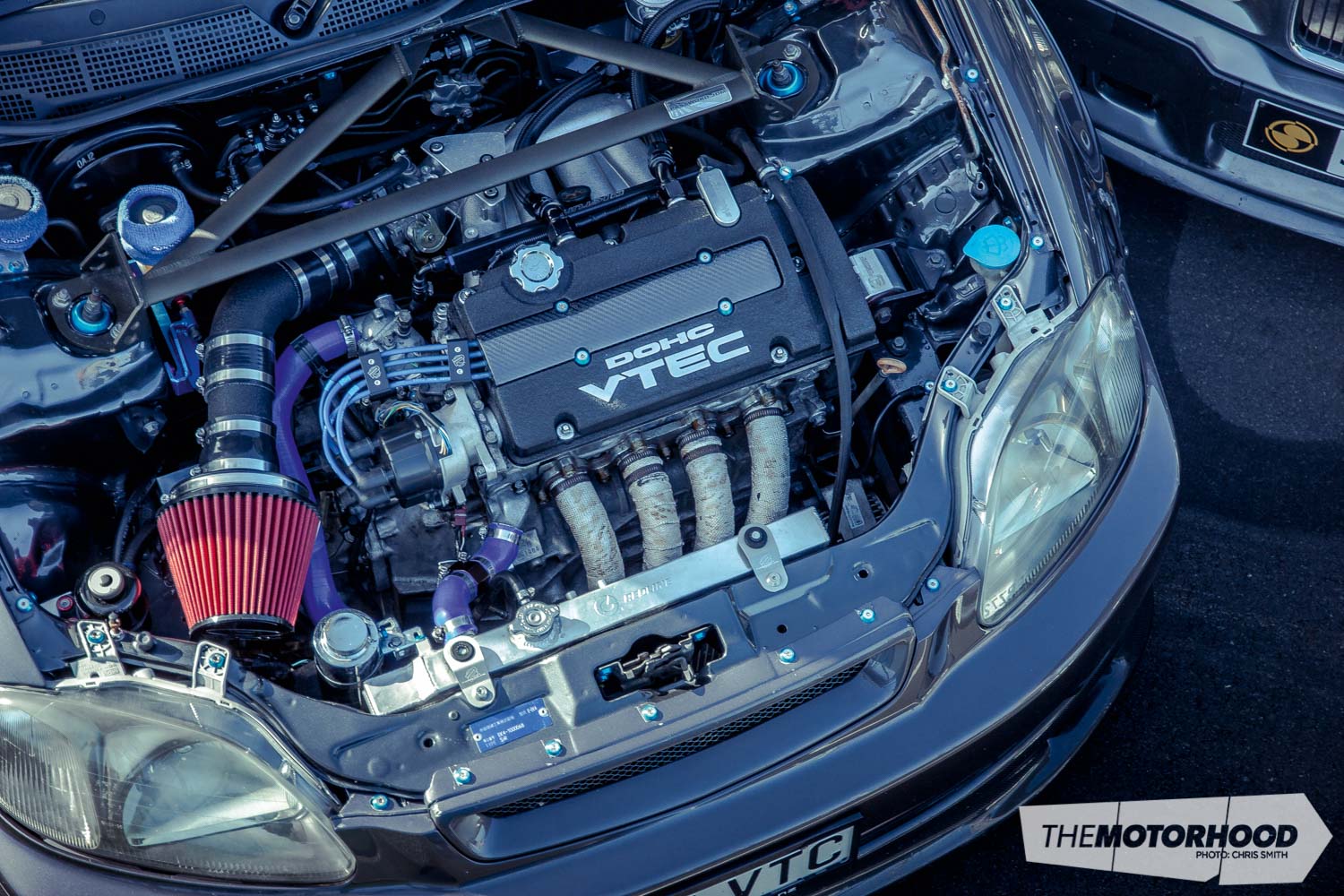
Make and model: 1995 Honda Civic Sir (EK4)
Heart
- Engine: Honda 2200cc H22A in-line four
- Block: Factory
- Head: Type-S Prelude camshafts
- Intake: K20A RBC intake manifold, Skunk2 70mm throttle body, three-inch intake pipe, Blox velocity stack filter
- Exhaust: PLM H2B headers with custom three-inch collector, custom three-inch exhaust, Megan Racing muffler
- Fuel: K20A 310cc injectors, K-tuned fuel rail, AEM fuel regulator, K-tuned in-line fuel filter, Speedflow fuel fittings
- Ignition: NGK 8mm racing leads, NGK spark plugs
- Cooling: Modified Redline radiator
- ECU: AEM V2 ECU, AEM wideband kit
- Extra: QSD H2B kit, QSD Moroso H2B sump, Kaizenspeed manual cambelt tensioner, Innovative billet engine mounts, full deloomed engine bay, Peterson oil catch can
Drive
- Gearbox: Factory Integra DC2 Type-R, M Factory final drive
- Clutch: Exedy full-face heavy-duty clutch
- Flywheel: Exedy lightweight flywheel
- Diff: Factory Integra DC2 Type-R
Support
- Struts: Cusco Zero 1 adjustable coilovers
- Other: Full Hardrace bush set, Blox front camber arms, Blox rear camber arms, Skunk2 rear lower control arms, Skunk2 rear lower tie bar, Password JDM three-point strut bar, EM Racing C-pillar bar, rear crossbar, MR2 power steering pump
- Brakes: (F) Wilwood four-pot front calipers, 262mm discs (R) Factory
Shoes
- Wheels: 15×7 inch A-tech Eraser
- Tyres: Toyo R888 205/50R15
- Other: Extended wheel studs, Skunk2 wheel nuts
Exterior
- Paint: Custom gunmetal paint
- Enhancements: OEM EK9 bodykit, Spoon Sports carbon front lip, Spoon Sports rear carbon wing, Buddy Club carbon bonnet, Spoon-style carbon wing mirrors, OEM Honda clear fog lights, facelift EK Civic tail lights
Interior
- Seats: (F) DC5 Recaro front seats, (R) EK9
- Steering wheel: Spoon Sports steering wheel, NGK short boss kit, NGK quick release
- Gear knob: Type-R, K-Tuned extended shifter
- Instrumentation: EK9 Civic Type-R gauge cluster
- ICE: Pioneer MP3/CD player, (F) Sony Xplod six-inch (R) Sony Xplod 6x9s
- Other: EK9 door cards, EK9 carpet
Power: 156kW (209hp) at the wheels, 0–400m: 14.4 on street tyres
Driver profile
- Driver/owner: Matt Edwards
- Age: 26
- Location: Auckland, North Shore
- Occupation: Sales rep
- Build time: Four years
- Length of ownership: Six years
- Thanks: My girlfriend Megan for supporting me, my Dad, Jacky and Colin at Jtune Automotive, Manolo, Alihan, Jarred, Antony at Albany Radiators, Seth at QSD, Adam at Speed Science
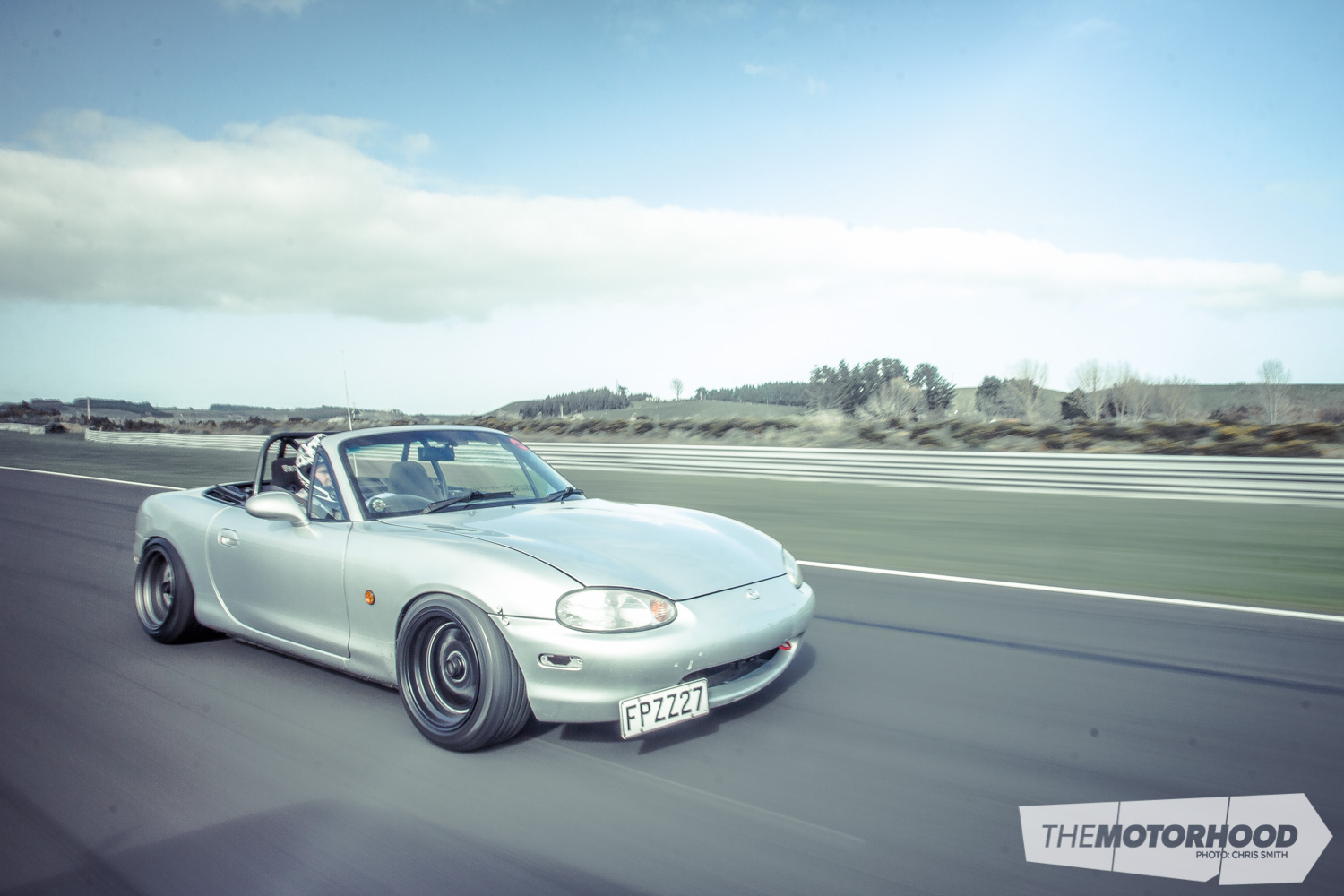
MX-5
After driving — or should we say drifting — a friend’s MX-5, William Cate was sold on the chassis and began a hunt of his own. He found himself a 1999 NB MX-5, but after just a low 800km after owning it, the motor ran a big-end bearing. Undeterred, he proceeded to drive it another 1200km like that, until the engine was finally pulled out to make way for a 13B.
William built up a Series 5 13B block with 48mm D-shaped peripheral ports, three-window race bearings, 3mm apex seals and a lightened and balanced rotating assembly. Sacrificing top-end power as a trade-off for increased mid-range torque, Sinco Customs built a long-runner intake manifold to house the 50mm EFI Hardware throttle body, fitted with 1000cc injectors. Sinco also built custom two-inch primaries to the diff, fitted with four Adrenalin R resonators and a three-inch muffler to finish.
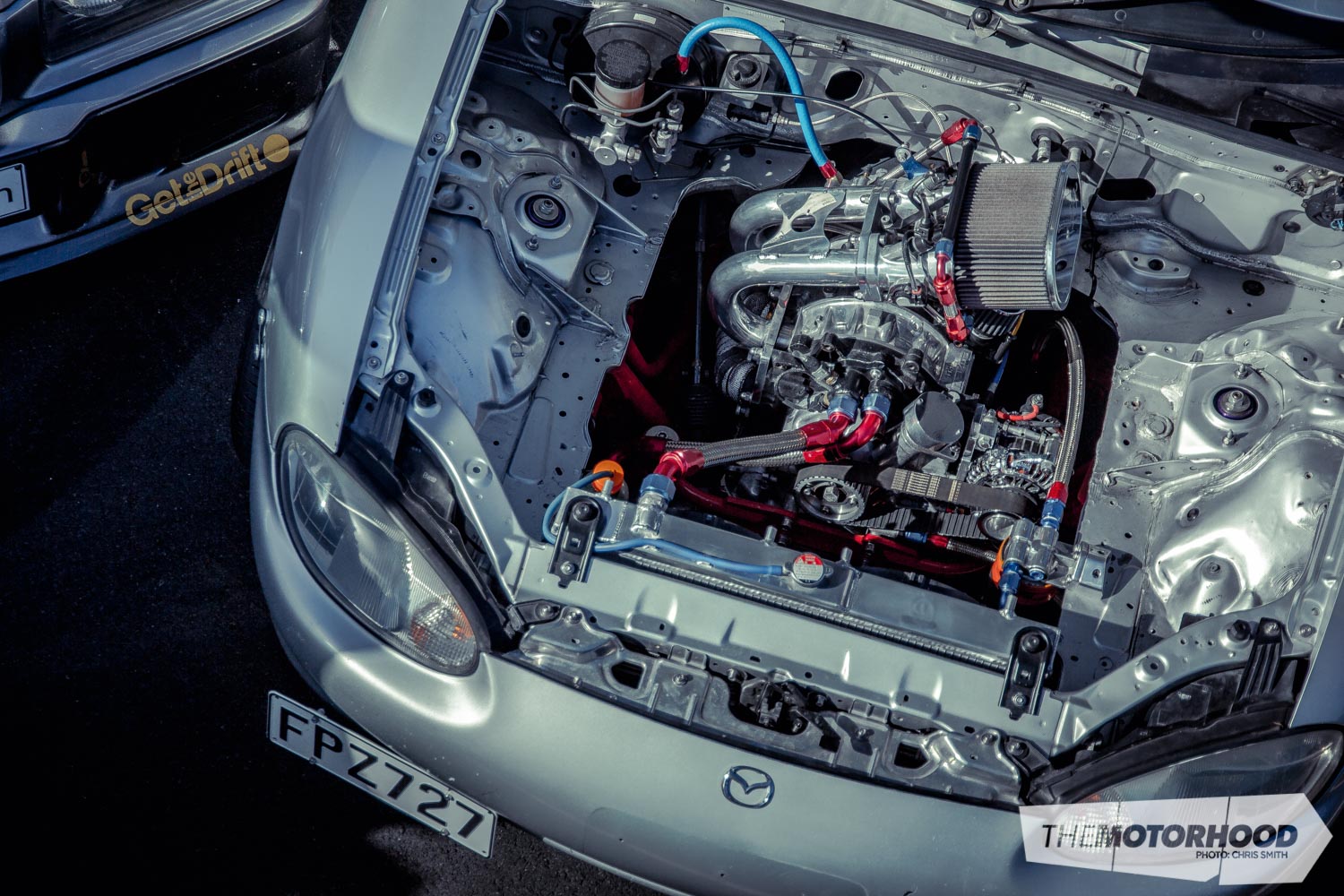
The 13B sits atop a modified Flyin’ Miata tubular subframe which was sourced from America, where they are used to install the LS-series V8 into these nimble Miata chassis’. To back the engine there’s a late-model MX-5 five-speed modified to fit the 13B. The MX-5 box offers a little more strength over your traditional RX-7 item, and also gives the car very long gearing — William was able to hit 80kph in second gear!
With drifting the main track-day focus, William installed a half cage, a Racetech 100 seat, Cusco two-way LSD, a full array of adjustable arms, Level 7 Tune knuckles and D2 coilovers. With a set of 15×8-inch XXR 002s with stretched Dunlop 195/50R15s the chassis seems a real handful, snapping back and forth in an instant — this is not a drift car for the lazy ones among ya, as despite the fact it runs an NA 13B, it had no trouble stepping out sideways and blazing the rear tyres during a few laps of Hampton Downs.

Make and model: 1999 Mazda MX-5 (NB)
Heart
- Engine: Mazda S5 RX-7 13B, 1300cc, two rotor
- Block: S5 RX-7, 48mm D-port peripheral ports, three-window race bearings, 3mm apex seals, lightened and balanced rotating assembly
- Intake: 50mm EFI Hardware throttle body, K&N filter, Sinco inlet manifold, trumpets
- Exhaust: Sinco twin two-inch primaries to the diff, then three-inch, four Adrenalin R mufflers
- Fuel: Walbro 373kW/500hp in-tank fuel pump, Sard fuel pressure reg, four 1000cc injectors
- Ignition: Four Bosch coils, 10mm custom leads, NGK spark plugs
- Cooling: Aluminium radiator, twin 10-inch fans, custom fan shroud, Davies Craig electric water pump with controller, oil cooler
- Other: Full de-loomed engine bay, Flyin’ Miata tubular subframe, custom engine mounts, custom side-mount alternator bracket, Gilmer belt drive, braided lines and AN fittings, remote oil filter
Drive
- Gearbox: MX-5 five-speed modified to fit 13B
- Clutch: Five-puck brass button clutch
- Flywheel:10lb flywheel
- Diff: Cusco two-way LSD
Support
- Struts: D2 coilovers
- Other: Adjustable camber arms, Level 7 Tune knuckles
- Brakes: Factory
Shoes
- Wheels: (F) 15×8-inch (0) XXR 002 (R) 15×9-inch (0) XXR 002
- Tyres: Dunlop 195/50r15s
Exterior
- Paint: Factory
Interior
- Seats: (F) Racetech 1000 driver seat
- Steering wheel: Grant steering wheel
- Instrumentation: Oil pressure gauge, MicroTech dash
- ICE: CD player
- Other: Roll bar
Power: 190kW (255hp) at the wheels
Driver profile
- Driver/owner: William Cate
- Age: 27
- Location: Hamilton
- Occupation: Automotive technician
- Build time: Five years
- Length of ownership: Five years
- Thanks: My dad for all the custom parts, my brothers, Sinco Customs, my work — Goodhue Automotive
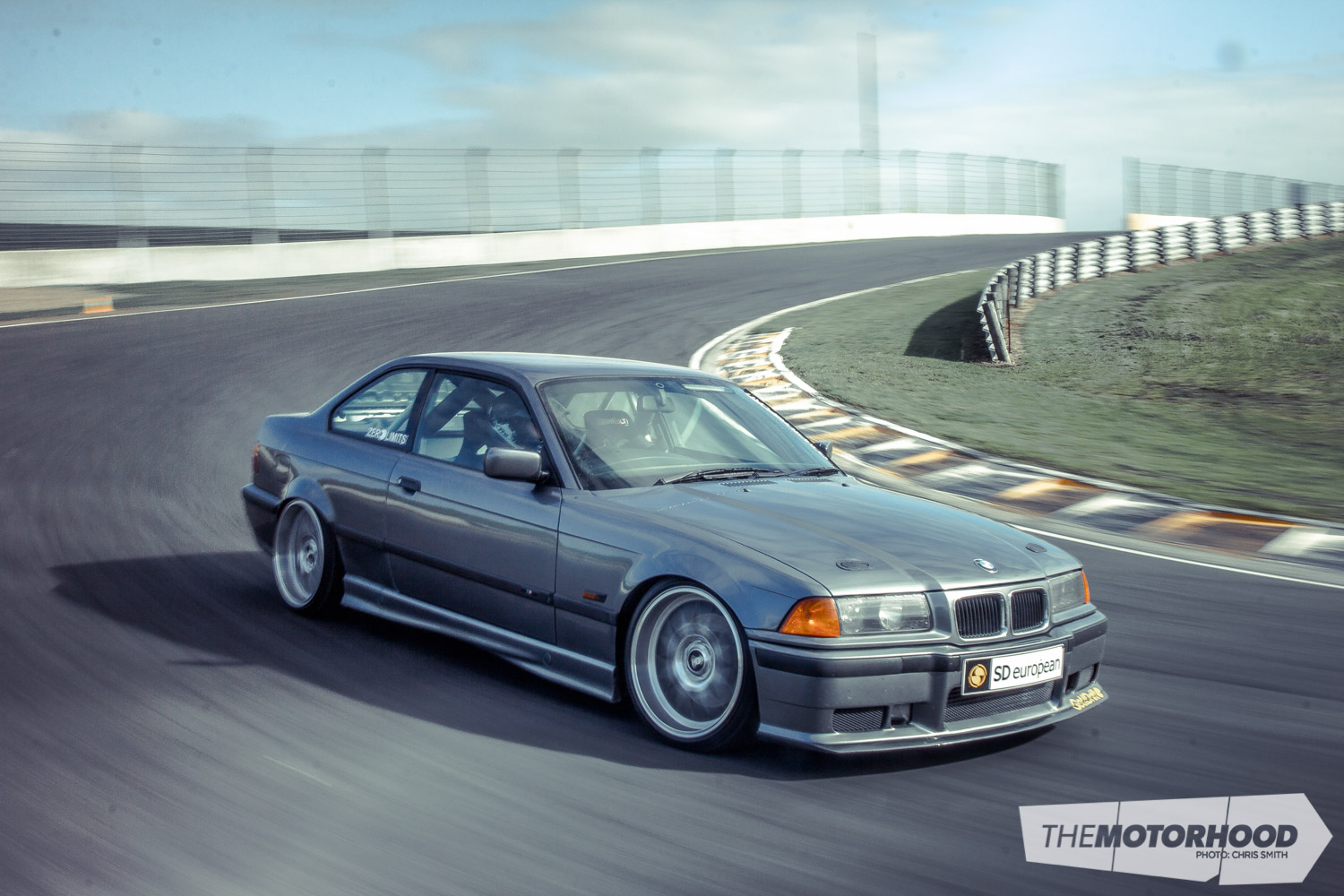
BMW E36
It was built as somewhat of an all-rounder, but the main goal for Garett Daly’s E36 build was to see just how fast he could get a BMW E36 turbo to go. Like a true weekend warrior, it sees time as a drift, track, drag and hill-climb car. Garett has owned this BMW E36 318iS for three years now, with the current build taking place over the past two years to transform it into what he calls his dream car.
The project kicked off when what was once his cheap daily driver needed more money in repairs for its next WOF than he was willing to spend, just to keep it on the road, so he decided to build a track car.
Garett set to work stripping the shell, and sourced an E36 2.8-litre six-cylinder from the yard (his family owns SD European) to replace the original 1.8 engine. The factory internals still remain, and seem to work just fine with the boost forced into the chambers from the Garrett T04Z twin-scroll turbo. Boost is controlled via twin 38mm TiAL wastegates and a Mac boost valve. Although it only runs 12psi, the T04Z has a large 1.0 A/R exhaust housing which sees those 2.8 litres push out 343kW at the wheels, tuned with a Link G4 Xtreme.
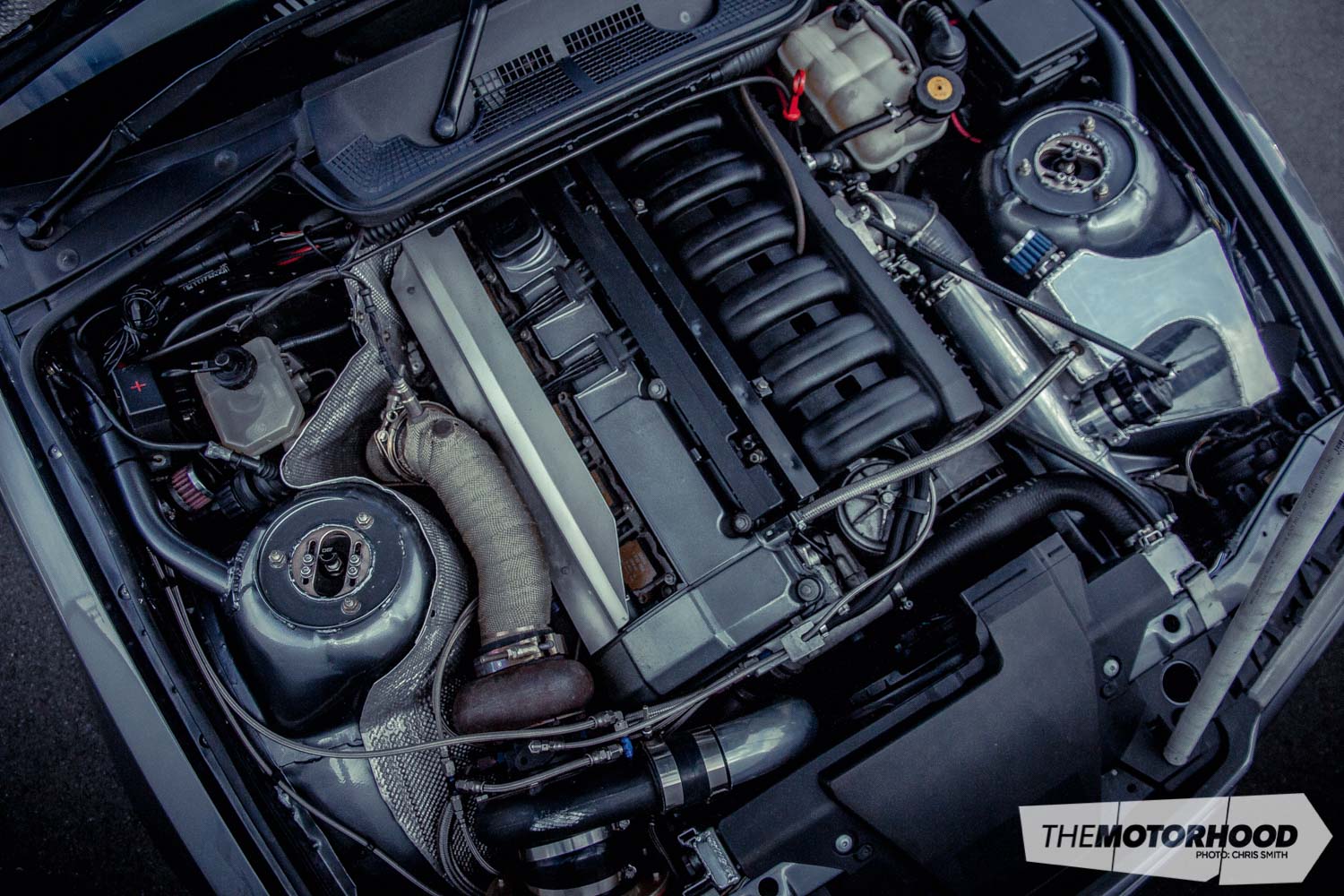
The BMW gets all that power down through a combination of E36 M3 componentry — the diff is the large-case M3 unit, the gearbox is sourced from an E36 M3, and it is all connected via M3 axles and an M3 driveshaft.
BC Gold coilovers and Hardrace arms deliver ride height, damper and camber tunability, while the eight-point roll cage provides the extreme amount of reinforcement, rigidity and safety required in a car of this calibre. Garett runs a set of 18-inch BBS RS-GT wheels front and rear, with legally-stretched Falken FK452 tyres, which he used on the day of testing. The E36 is not road legal, but he plans to get a cert ASAP.
This was the most unassuming of the three cars we tested, but was the fastest and most stable in drift.
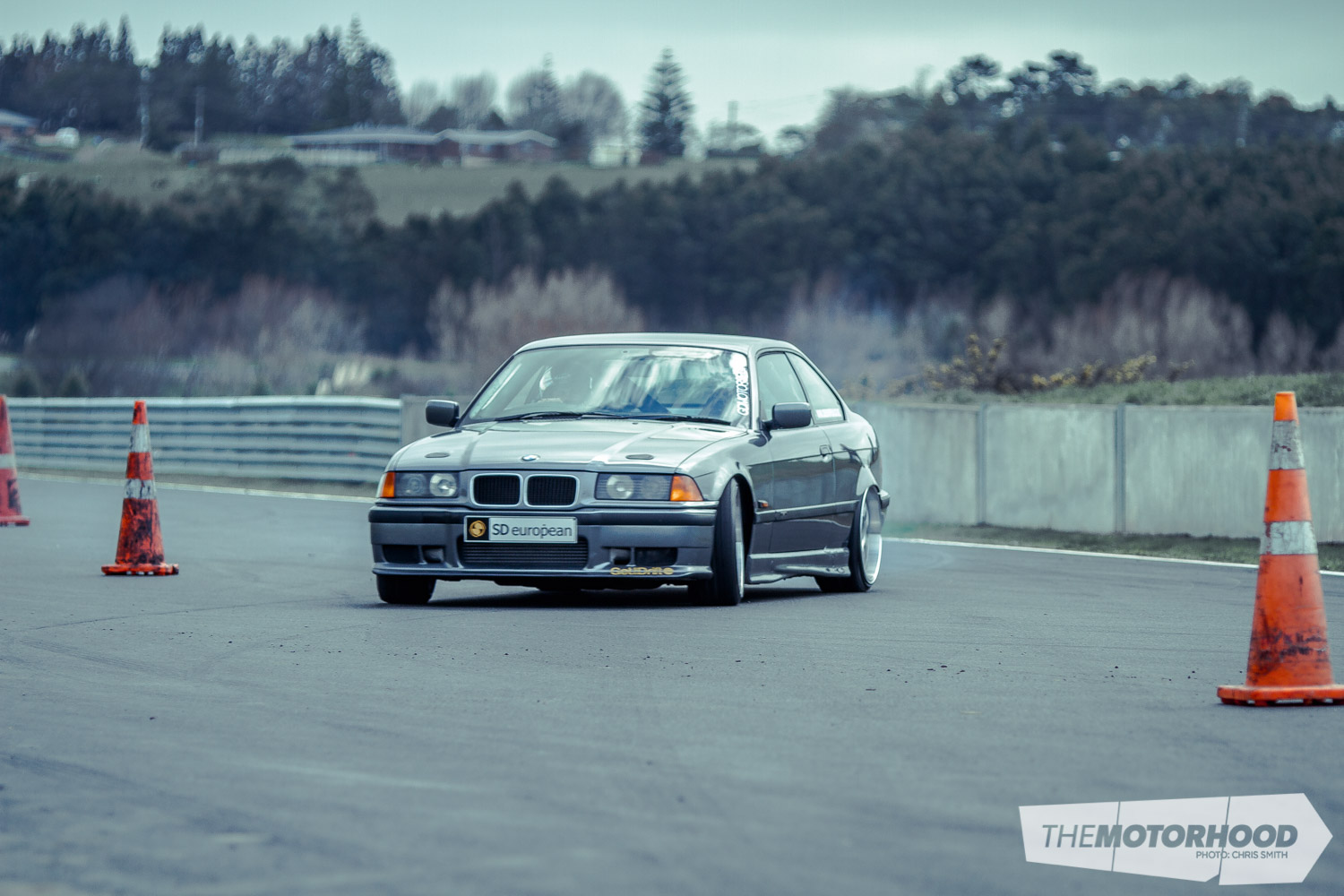
Make and model: 1992 BMW E36 318iS
Heart
- Engine: BMW 2800cc six cylinder
- Block: Factory
- Head: Ported head
- Intake: HKS pod filter, custom intercooler piping, 400x120mm intercooler
- Exhaust: Heat wrapped and ceramic-coated mild steel three-inch dump pipe, three-inch exhaust system, twin louvred core resonators, offset rear muffler, ceramic-coated twin-scroll exhaust manifold
- Turbo: Garrett T04Z twin-scroll (1.0 A/R rear, 0.70 front)
- Wastegate: Twin 38mm TiAL wastegates watercooled
- BOV: TiAL 50mm
- Fuel: Bosch 044, 2.5-litre surge tank, 875cc Siemens injectors, factory 3.5 bar fuel pressure regulator and fuel rail
- Ignition: Factory coils, NGK plugs
- ECU: Link G4 Xtreme, LC-1 wideband controller with gauge, Mac boost solenoid
- Cooling: Fenix alloy radiator, BMW mini electric puller fan with custom bracket, custom coolant distribution block to feed turbo and wastegates
- Extra: Seam-welded engine bay, custom 2.5-litre catch can, E46 under-car heat shielding redesigned to shield car from the turbo and exhaust heat
Drive
- Gearbox: E36 M3 five-speed
- Clutch: Uprated pressure plate (3860lb), ceramic 225mm six-paddle plate, BMW E21 release bearing
- Flywheel: M20 steel flywheel
- Diff: Large-case E36 M3 LSD, 3.15 ratio
- Other: E36 M3 main driveshaft and axles
Support
- Struts: BC Gold series coilovers
- Springs: BC Gold front, Custom BC Gold rear
- Other: Welded-in strut tower top-support mounts, E36 M3 front lower control arms and bushes, Eibach adjustable front and rear sway bars, Nolathane diff mount and rear subframe bushes
- Brakes: (F&R) Znoelli E36 M3 heat-treated rotors, racing pads, Castrol React fluid
Shoes
- Wheels:(F) BBS RS-GT 911 18×8.5-inch (R) BBS RS-GT 18×9.5-inch
- Tyres: 225/35R18 Falken FK452
Exterior
- Paint: Full panel and paint
- Enhancements: E36 M3 side skirts, front bumper and rear bumper
Interior
- Seats: (F) Racetech RT1000, modified sliding E46 rails
- Steering wheel: Sportline suede steering wheel
- Gear knob: Solid alloy
- Instrumentation: Oil pressure, boost, air/fuel ratio
- Other: Stop light on front windscreen, eight-point roll cage with rear strut reinforcement
- ICE: CD player with USB function
Power: 343kW (460hp) at the wheels on 12psi, 0-400m: 12.37sec
Driver profile
- Driver/owner: Garett Daly
- Age: 31
- Location: Hamilton
- Occupation: Service manager at SD European
- Build time: Two years
- Length of ownership: Three years
- Thanks: First I’d like to thank my father Steve at SD European in Hamilton (0800 269 772), my little bro Brook, my friends, Andrew Stewart at AWS Graphics Hamilton (0274 399 212), Brent at Dynopower Tauranga (07 578 3332), Jonny Powers, Mike at Sinco Customs Hamilton (07 847 3392), Neil at Auto Clutch Auckland (09 849 3737), Nyle and Steve at GSS Performance Auckland (09 525 6858), Brendon at Pro Wholesale Tauranga (07 543 3266), Pro Coat Auckland (09 274 5459), Mac Valves Auckland (09 634 9400), Bay Engineers Supplies, Hamilton (07 850 9929), Fred at Speedwall Hamilton, Carl at LEDstuff Auckland (0800 LEDSTUFF), Craig Howser, Fairview Motors Hamilton (07 849 9899), Paul Byers, Jacob, everyone else who I have missed.
Putting them through their paces
Cone course
The key to a decent track car is finding that balance between grip, power and handling. To test this we set up a slalom course, and gave each driver two cracks. As simple as the course layout looks, it tests braking, agility and power. Four cones in a straight line, spaced at varying distances, made up our test course, and the drivers needed to slalom through them from beginning to end, then return, before planting it for the sprint to the final cone.
Matt stepped up first. The Civic grips off the line extremely fast, the Toyo R888s doing their job well. He looked competitive through the slalom, but the Civic soon came to its demise — the final cone. Front-wheel drives never have the best steering lock, and Matt’s Civic was no different. The handbrake didn’t comply due to the grippy semi-slick tyres, and Matt had no choice but to run the Civic onto the grass at both the start and finish cones.
But despite its terrible turning circle, the Civic was not the slowest, as it made up for its bad steering angle with rapid acceleration and a tight slalom.
Second to hit the course was Garett in the BMW. The M3 LSD diff provided the BMW with great traction off the line, however, once the boost kicked in that traction turned into clouds of smoke. Once in a slide Garett slid the BMW through every cone, with big handbrakies around each final cone, and then made the dash toward the finish line. The BMW had the most power, but ironically looked promising on this tight little course.
Next it was William’s turn to line up his MX-5. With first gear spinning out to 80kph, that was where he left it. The 13B PP screamed as William slid through each cone with precision and smoke billowed off the rear tyres. At this stage we thought the MX-5 was the quickest, but a combination of a bit too much handbrake and speed meant it spun out, which cost him valuable time.
The MX-5 made it through the final cone, with what was definitely the best show out of the three.
Cone course
1st place: BMW, 25.98sec
2nd place: Honda, 28.13sec
3rd place: Mazda, 33.64sec
0–100–0 Test
This test involved a standing start accelerating to 100kph, then hit the brakes, and was again dominated by the big six-cylinder BMW. The MX-5 with its tiny 195/50 Dunlops struggled to leave the line, but once it got going it quickly reached 100 before the stock brakes locked up and required a little feathering to pull the lightweight Mazda up. On the other hand the Civic was rapid to launch and reached 100 faster than the other two, but a few lock-ups under brakes hurt Matt’s time. Off the line Garett’s BMW struggled for grip a little but drove out of it and reached 100, then he hit the picks and only a small lock-up before coming to a complete stop, just shorter than the Civic.
0–100–0
1st place: BMW, 8.92sec
2nd place: Honda, 9.62sec
3rd place: Mazda, 10.95sec
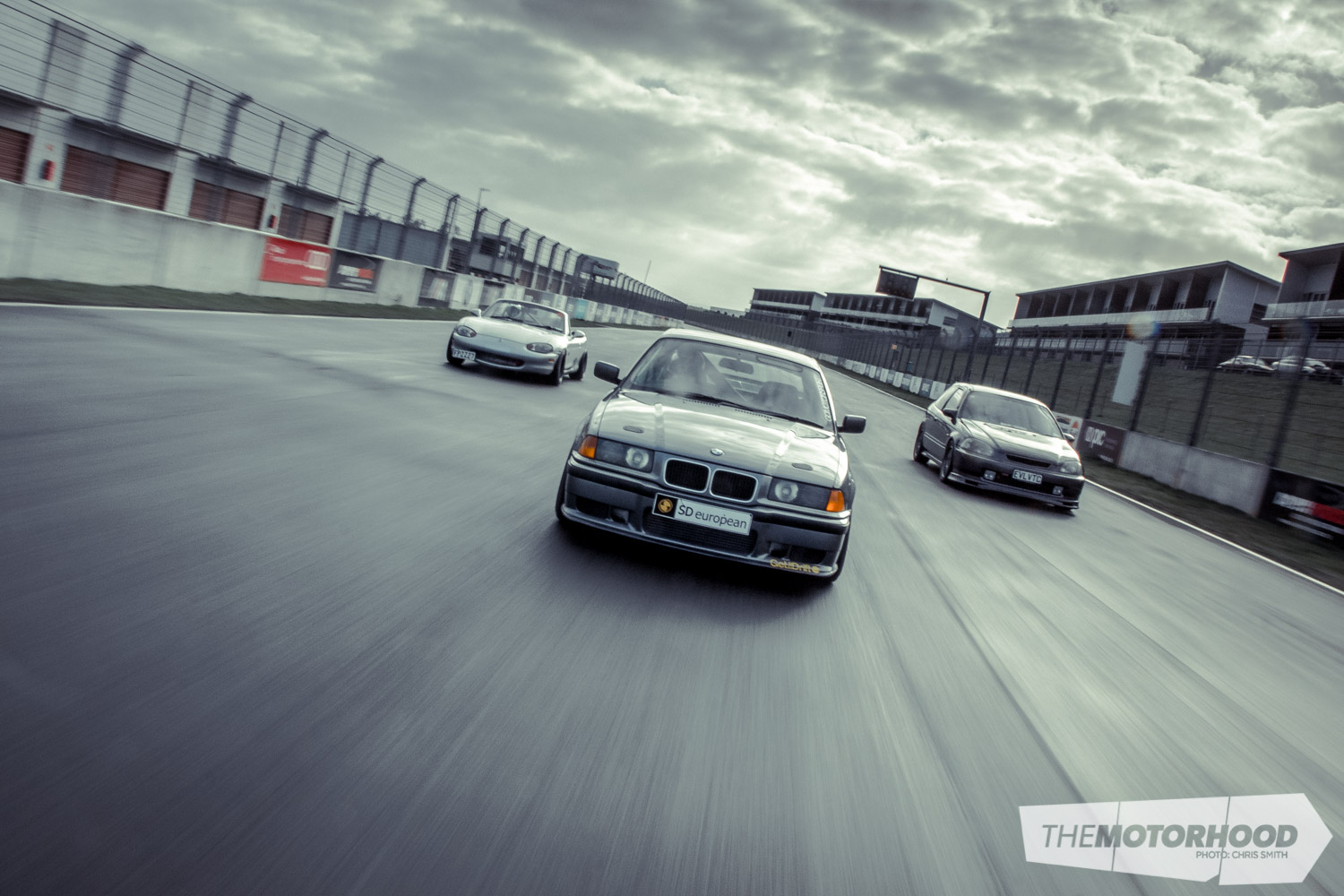
Which was our favourite?
These three cars are all fantastic in their own right, but the best performers in our opinion had to be the BMW and the Honda. The BMW was the outright top scorer. It had huge power, amazing handling and won all the tests we conducted. The Honda was by far the best bang-for-buck. Matt drove the well-presented Civic down to the track, had a blast all day during our testing then drove the car home, and he was confident in doing so. The Honda wasn’t far off in terms of performance either, if not for its poor steering lock it would have been a fair fight for the number-one spot on the slalom course.
Matt’s Civic was also less than a second behind in the acceleration/braking test, as a combination of close-ratio gearing, the torque-heavy H22A and the Wilwood brake package worked extremely well together. The Mazda was the least competitive package, as although it has more power than the Civic, it was running stretched tyres, factory brakes and very firm suspension, a combination that didn’t work well together during our test, but in saying that it was not set up specifically for our tests, and could handle any drift situation. It was the most fun to watch throughout the day, it sounded amazing, and William rarely hesitated to give the Mazda absolute death — proof the Miata is still one of the most enjoyable track days cars available.




